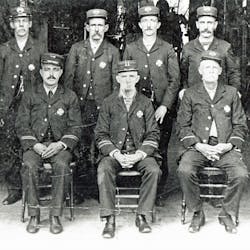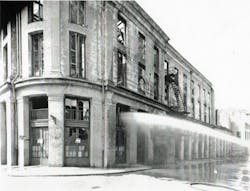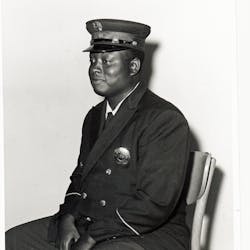New Orleans Fire at 130: Pompiers and Circumstances
On Dec. 15, 2021, the New Orleans Fire Department (NOFD) celebrated its 130th anniversary. The NOFD provides fire protection and first responder emergency medical services to the approximately 390,000 people who live in the 350-square-mile city and has a Class 1 rating from the Property Insurance Association of Louisiana. The annual budget for fiscal year 2020 was $122.4 million. The NOFD, which is led by Superintendent Roman Nelson, has 6 districts, 29 engines and 6 ladder trucks and is staffed by 567 members. In 2020, the NOFD responded to 45,549 calls. Additionally, the NOFD provides airport rescue firefighting services to the Louis Armstrong New Orleans International Airport.
The mission statement of the department reads: To respond to all emergency situations in the city of New Orleans to protect and save life and property. Further, to strive to reduce the incidence of fire and the loss of life and injuries to civilians and fire personnel.
The vision statement reads: NOFD will explore every opportunity to promote safety awareness and will provide our community with all-hazard emergency services, including preparedness, planning, response and mitigation.
At approximately 1 p.m. on March 21, 1788, which happened to be Good Friday, a huge fire occurred in New Orleans. A candle on an alter in the home of Don Jose Nunez accidentally ignited his lace curtains. Gale force winds fanned the flames, lighting Nunez’ Chartres Street home ablaze.
In those days, the bells on the Church of Saint Louis called residents to assembly during emergencies. Catholic tradition says, however, that bells never toll on Good Friday. As a result, no alert was sounded. It’s estimated that more than 800 wooden homes were destroyed, as the fire (which came to be known as the Great New Orleans Fire) virtually wiped out the entire city. What took 70 years to create was gone in a mere five hours. It was then that Governor Esteban Rodriguez Miro decided that the city needed an organized group to handle fires.
The first official reference to the subject of organization against fire appeared four years later when police officials were directed to take charge of the new “fire engines” and assume command at all fires. Then, in 1804, the City Council received a request to have 15 men, commanded by a foreman, assigned to each of the four engines that were in service.
In April 1829, a larger group of men joined together to fight fires, the first major step to organize a first-class volunteer fire department in New Orleans. These volunteers went under the name of the Firemen’s Charitable Association (FCA), a title that the department kept for 62 years. Henri Buckman was selected as the foreman and first chartered member of the FCA and served all 62 years of its existence, which led to him being officially declared as the father of the fire service in New Orleans.
In 1854, Thomas O’Connor joined Company No. 19 at the age of 15. Four years later, he became eligible for full membership in the FCA, joining Columbia No. 5. O’Connor was elected head of the department in 1869.
On Dec. 15, 1891, the volunteer FCA transitioned to a paid department and came into existence as the New Orleans Fire Department. Becoming a paid department ensured that one of the most culturally rich and historically relevant cities in all of the Americas had the safety and security of a prompt response from professional trained firefighters. O’Connor remained on as the first chief of the NOFD and continued to lead it for the next 20 years.
O’Connor would go on to write “The History of the Fire Department of New Orleans,” which is a 500-page book that details the workings of the fire service in the city from the early pioneer days, through the days of the volunteer department, to the first years of the paid department.
The first fire that was fought by the paid New Orleans Fire Department occurred on Feb. 17, 1892, at the corner of Canal and Bourbon Streets. Kinked hoselines delayed the attack on the fire, which extended to the next building. As at all major fires, a large crowd gathered, among them many volunteer firefighters, who pitched in to help their comrades-in-arms. Leaping over the restraining lines, they straightened the kinked hoses, which enabled the fire at A.W. Schwartz’ General Store to be extinguished.
The first two men to give their life in the service of the NOFD were Dan Golden and Dominick Parera, who were killed in a fire on Oct. 9, 1892. The NOFD has suffered 98 line-of-duty deaths in its 130-year history.
The department’s first “horseless engine” was placed in service on Sept. 5, 1900. The new engine had a steam boiler and was placed in service as Engine 2. Engine 23 was the last company to have a horse-drawn apparatus. It was placed out of service and a new motorized pumper placed in service on April 27, 1922.
On Feb. 22, 1965, history was made, when just barely six months after the Civil Rights Act of 1964 passed to ban discrimination, Firefighter George Mondy Jr. opened the doors of professional firefighting to African American citizens of New Orleans. A former Marine Corps drill instructor, Mondy was one of the founders of the Black Association of New Orleans Firefighters (BANOFF), achieved the rank of apparatus operator and, in 1991, retired after 26 years of service with the department.
The department moved into the computer age in July 1973 when a new communications system was unveiled. The new system included a five-channel radio system and teleprinters in the fire stations and chiefs’ vehicles. Construction also began on a completely new building to house the Communications Division.
Major strides for fire safety were made in 1974 when Superintendent William J. McCrossen and the NOFD helped push through the State Legislature a bill that adopted fire safety standards for high-rise buildings. With passage of the legislation, Louisiana became the first state in the nation to, for all practical purposes, require automatic sprinkler systems in all high-rise buildings that were constructed after 1975. Later in the year, a strengthened version of the law was adopted as a local ordinance by the City Council.
History was made again on Jan. 22, 1993, when Kathy Wilkerson graduated from the department’s training academy, becoming the NOFD’s first female firefighter.
Another historic first occurred on March 10, 2012, when Firefighters Linda Pailet and Katherine Jahncke were promoted to captain, which made them the first female officers in the department’s history.
A fatal fire that took the life of five family members in November 2014 triggered the NOFD to escalate its Smoke Alarm Program, which follows the International Association of Fire Chiefs’ recommendation for a door-to-door effort and duplicates the initiatives of major progressive fire departments across the nation.
The NOFD celebrated 125 years in 2016. The occasion was marked by a change in the design of the department’s duty badge for the first time in 100 years. The emblems replicated the original badges that were issued to members at the inception of the department in 1891. Members were authorized to wear them throughout the year.
What’s new?
The NOFD continues to rebuild following the devastation of Hurricane Katrina (see “Hurricane Katrina & the NOFD”). Thanks to FEMA-provided funding, the department refurbished several stations in the past few years to provide the best conditions possible for its firefighters. With the effects of hurricanes in mind—specifically the sometimes lengthy power outages–natural lighting and backup generators have come to the fore. Amid the same efforts, gender-specific facilities were included for the first time at NOFD firehouses.



